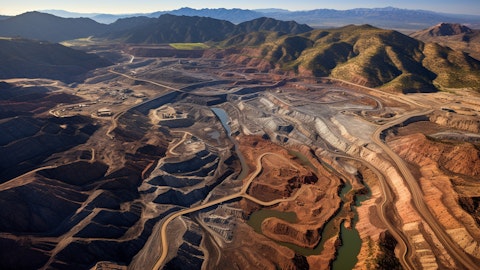Lawson Winder: Okay. No problem then. Maybe I’ll just leave the guidance there then. The other question I wanted to ask actually was about Cortez and the Goldrush aspect of that. So Goldrush, you guys actually have multiple royalties. And on one portion of Goldrush, it’s higher than the other. And so what I wanted to understand is as Goldrush ramps up, when based on the current mine plan, would Royal Gold start to get the benefit of that higher rate? And is there a point where there’s an overlap in the royalties such that the two are additive?
Bill Heissenbuttel: Yeah. The area of Goldrush where we have a higher royalty rate, I think, is in the far southeast portion of it. Martin, do we have an estimate of timing as to when that might come in?
Martin Raffield: It’s far, far in the future.
Bill Heissenbuttel: Yeah, that’s what I thought.
Lawson Winder: Okay, that’s very helpful to know. Thank you both very much. I appreciate that.
Bill Heissenbuttel: Thank you.
Operator: Our next question comes from Tanya Jakusconek with Scotiabank. Please go ahead.
Tanya Jakusconek: Great. Good morning, everyone. Thank you so much for taking my question. I just wanted to come back to Crossroads. I was the one who asked Barrick on the call yesterday about Crossroads and what exactly has happened. And maybe my understanding, which may be different from yours and — was that we have this fault that they thought was an area where they had high grade, and when they did additional confirmation drilling, the fault seemed to have — was there that they hadn’t expected and we lost these high-grade goals. But my understanding was that we also have lost reserves and resources from this area as well. Is that your understanding? So are you expecting also a decline in the reserves and resources in this area?
Bill Heissenbuttel: Martin, I’m going to hand that one to you.
Martin Raffield: Thanks, Tanya. We don’t…
Tanya Jakusconek: I know. Sorry, Martin, but it was just — go ahead.
Martin Raffield: Yeah, look, I think we would expect some change based on what has been said over the past couple of days. But I can’t really give you any detail around that because we haven’t seen the detail ourselves yet.
Tanya Jakusconek: Okay. So I guess from our perspective, just for the 2024 number, from what very high-level guidance you’ve provided, it would be safe to assume that, that 49,000 GEOs was — that you achieved in 2023, we can remove maybe 20,000 off that number for 2024?
Martin Raffield: Yes, that’s exactly right.
Tanya Jakusconek: Okay. And then we will wait. Would you know about these reserves and resources when you report — when you give us guidance in April in your new reserves…
Martin Raffield: Yes. We’re going to…
Tanya Jakusconek: All right. Okay. Maybe we can come back…
Martin Raffield: Yeah. So we will try and give more detail around that.
Tanya Jakusconek: Okay, all right. Thank you. And maybe I guess, I’m just going to come back to just the M&A environment yet again. You mentioned now you’ve paid off a lot of your debt. Just wondering, what you are seeing out there and size-wise and how big would you be looking at in terms of potential transactions?
Bill Heissenbuttel: Yes, Tanya, I’ll hand that over to Dan to make a comment.
Tanya Jakusconek: Thank you.
Dan Breeze : Sure, Bill. Hi, Tanya. Hi. Thanks for the question, Tanya. Look, I think — well, as you know, we didn’t announce a transaction last year. But looking back, I think it was one of our busier years with the internal reviews that we do on opportunities. And I think what you saw in the market and maybe we’re going to see or at least in the near term is probably representative of the state of the market right now, which is smaller lots, but smaller opportunities across the board. And I think it’s really being driven, Tanya, still by a high cost of debt right now in the equity markets, which maybe they’re recovering a little bit now. But generally, they’ve been less supportive of smaller companies, in particular, those with single asset development project type risks.
So I think that’s what’s driven these smaller royalty financings that we’ve seen in the market in the last 12 months or so. I think that’s going to continue. But we do still see that we obviously are in the same range of $100 million to $300 million. I think that still holds, but there are many more opportunities at the lower end of that size range, right? It’s busy. And I think — as I said, I think, it’s being driven by other types of capital just not being readily available right now.
Tanya Jakusconek: Okay. And can I ask about you’re ready to have —
Bill Heissenbuttel: Does that answer your question?
Tanya Jakusconek: Yes, that’s — thank you. So, similar range, similar sort of structure helping the smaller guys. Question for you. Obviously, Newmont is looking to solve some of the assets and my understanding is that the data room is open and people are looking. And have you seen or heard of any opportunities for you there?
Bill Heissenbuttel : Yes. I mean, go ahead, Dan.
Dan Breeze : Well, we’re — sorry. Bill, go ahead.
Bill Heissenbuttel : No, I was just going to say, look, we always point to these events as opportunities for stream financing. And to the extent we can be a good financing partner in that process, we are always happy to do it. The only caveat being we said the same thing about Barrick and Randgold. We said the same thing about Newmont and Goldcorp and really didn’t see much develop. So we certainly have our eyes and ears open. But I guess I wouldn’t want you to say, yes, there’s going to be a lot of opportunity based on the disposal process.
Tanya Jakusconek: Would you, Bill, increase your exposure to Africa if there was an opportunity for a stream there?
Bill Heissenbuttel : Sorry, which asset?
Tanya Jakusconek: Just in Africa, the continental Africa. Would you take on that higher geopolitical risk?
Bill Heissenbuttel : That’d be very country-specific. We’ve had a very good experience in Botswana. We haven’t had a bad experience in Ghana. But again, eyes wide open there. We’ve had a long-term reluctance in South Africa. So I would say, the number of countries in Africa where we would be comfortable is maybe a handful and you might not need all the fingers on your hand to do it.
Tanya Jakusconek: Okay, got it. All right. Thank you so much. I really appreciate it and really would hope for more clarity on the Crossroads, if you could, by April.
Bill Heissenbuttel : Yes. Thanks, Tanya.
Tanya Jakusconek: Thank you.
Operator: The next question comes from Brian MacArthur with Raymond James. Please go ahead, Brian.
Brian MacArthur : Good morning. Most of my questions have been answered, but can I just ask, for the Mount Milligan deal, how this will be accounted for, i.e., when you get the gold payments and you get the free cash flow at the bottom; is that going to be through revenue and be counted as GEOs? Or is it going to be if, I just want to think of it as other cash items coming through?
Bill Heissenbuttel: Yes. Brian, I’m going to ask Paul to step in here and talk a little bit about the accounting. The only thing I — the only caveat I will give you is he’s going to tell you that they’re working on the finalization happening. So, bear with them a little bit.
Brian MacArthur: Yes, I’m sure.
Paul Libner: Yes. Hey Brian, how are you? And Bill’s right, we obviously need to qualify some of these statements with that fact that, yes, we’re still evaluating the accounting treatment, but we do expect to complete that analysis here during our first quarter, at which time we’ll certainly give you more information with our next report. But as I sit here today, the consideration that we received obviously was the cash as well as the deferred gold ounces. I do anticipate bringing those on to the balance sheet certainly as a receivable. And obviously, since that receivable is in the form of gold, the commodity, I do anticipate that we will have to mark-to-market that receivable through the P&L each subsequent reporting period.
As far as the — when the time comes that we receive those ounces, obviously, through that mark-to-marketing, if you will, over time, we’ll take those ounces into inventory under our policy and we’ll sell those. I can’t say today with certainty that it would be revenue, I don’t think would be revenue. It could be some other form of an income, maybe not revenue, which equals then GEOs. But again, more to come on that, but that would be where I would see things today.
Brian MacArthur: So, can I maybe just ask, I mean, I guess I can see the deferred gold maybe one way. But for the 20 — I mean, the money you’re going to get in upfront, I mean, I guess where it goes is obviously with Cortez coming down, your growth rate in GEO isn’t going to be that high this year, I suspect. So, I mean, you’re going to count that $25 million as part of GEO growth this year because it is, in a way, I guess, part of that stream? And it’s not an insignificant amount of money.
Bill Heissenbuttel: No, I mean, that wouldn’t touch revenue.




